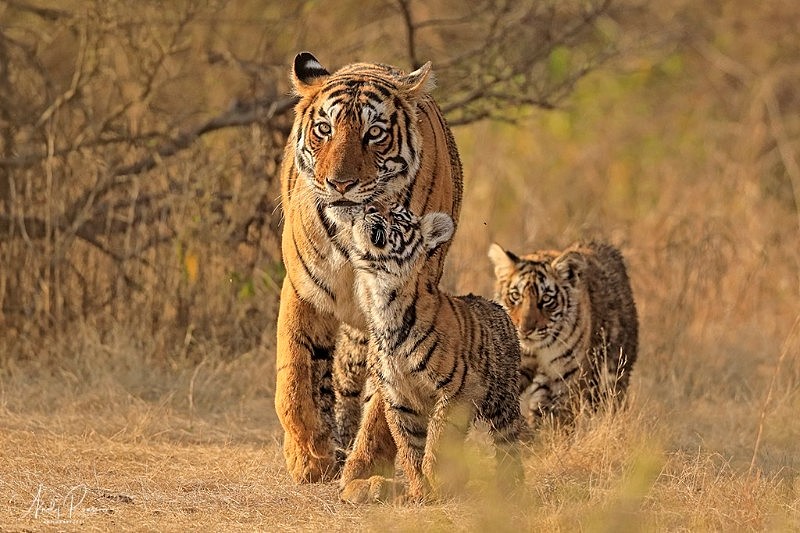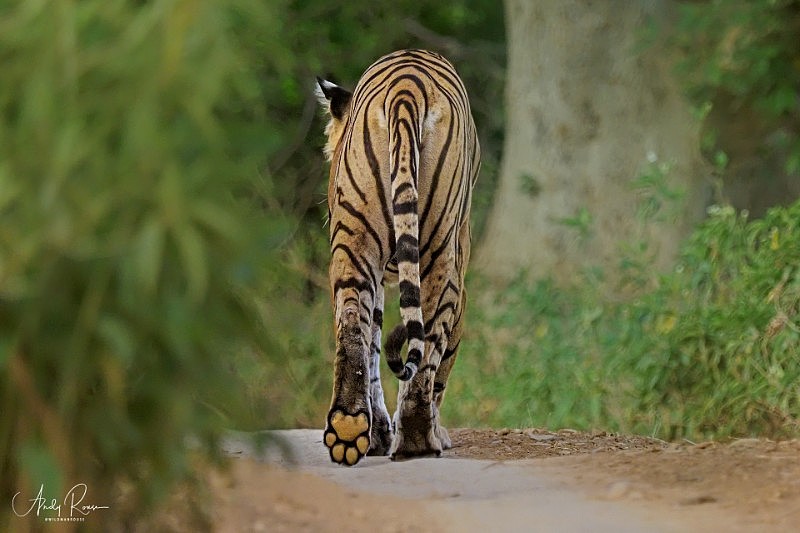
Intro
Ok this is the first guest BLOG I have done and I think it's a vital one. With the recent controversy over Pretty Boy T104, the death of T109 Veeru and now the news that a young boy has been killed by another tiger outside zone 10 there has been a lot of talk that there are too many tigers in Ranthambhore. So Dr Dharmendra Khandal, a Conservation Biologist for local Ranthambhore NGO since 2003, alongside Bhuvanesh Suthar, wrote this special study which we have incorporated here for all to see. In order to make effective decisions about the park we need proper information from people on the ground, not subjective and emotional outbursts!! Whenever Dicky and I need anything confirmed we turn to Dharmendra, as he is on the ground and usually present first when any of the issues occur. So below is his report on the status of tigers in Ranthambhore and at the end some info on Tiger Watch alongside some of my conclusions. Throughout I have used a few tiger pics to break up the text. Alright let's go!
Today, Tiger Watch did an in depth analysis of the current status of Tigers in Ranthambhore. There is consistent discussion and debate on the notion that there are 71 Tigers in Ranthambhore Tiger Reserve, but that there is only space for 50-55 Tigers. The correct conclusion can only be arrived at when statistics are taken into account.
1. First, understand that Ranthambhore is an area of 1700 sq kms, of which 650 sq kms are suitable for Tigers. The rest is not suitable because of human pressure.There are 2 divisions in the Tiger Reserve - Ranthambhore and Kailadevi
2. According to our data and analysis, the Kailadevi division has 5 Tigers while Ranthambhore has 57 Tigers. Therefore, that makes 62 Tigers in total, NOT 71.
3. Of these 62 tigers, 50 are adults and 12 are cubs.
4. There are 3 adults and 2 cubs in Kailadevi division. Therefore, that makes a total of 5 Tigers in Kailadevi.
5. Of the 57 Tigers in the Ranthambhore division, 10 are cubs, which are still do not have identification numbers ( for ex. T-XX). Only 47 of these Tigers have unique ID numbers and you can consider these to be adults.
6. Even among the 47 'adult' tigers in Ranthambhore division, 4 are still with their mothers, therefore in reality there are 43 adults in this division. The remaining 10 4=14 in this division are still with their mothers. However, 10 of these tigers are on the verge of leaving their mothers, therefore these can be considered adults.

7. Another popular notion is that there are too many male Tigers. However, If you examine the 47 adult tigers in Ranthambhore division, you will find 23 males and 24 females.
8. Among the total cubs in the Tiger Reserve, 10 ( Ranthambhore division) 2 ( Kailadevi division) , it is not possible to accurately determine the sex of all of them.
9. Also keep in mind that of the 23 male tigers in Ranthambhore division, 10 are yet to establish their own territories while 13 have established their territories.
10. Among the 13 male tigers with established territories in Ranthambore division, 5 are old, and their territories can be usurped by any one of the 10 males without any territory.
11. Among the 24 tigresses in Ranthambhore division, there are 9 which have not borne cubs as of now.
12. Among the 15 adult tigresses, 5-6 are old and will lose their territories to any one of the 9 tigresses yet to have borne cubs. This is necessary and will ensure that the breeding cycles of Ranthambhore's tigers carries on.

Conclusions
Thanks Dharmendra for this balanced assessment based on field observations of Tiger Watch. As you can see the population dynamics in Ranthambhore are healthy and working exactly as it should be. Young male tigers are kicked out at 3 years of age and have to roam to find their place in the world. Whilst there are very dominant male tigers with established territories some of these are old and the crop of mature male tigers ready to take their place is healthy. Certainly for me, the number of mature females yet to have cubs is a healthy sign of the population going in the right direction, after all we don't want to revert to the situation 20 years ago when we were seriously concerned about the population in Ranthambhore.
So how does this info apply to the recent unprecedented number of man-tiger conflicts in Ranthambhore? Well I'm not an expert just someone with experience, to me it seems like just a matter of timing. Suddenly we have had a number of maturing male cubs searching for territories in areas of the park where there are existing and powerful males. So they have no choice but to move out to the bordering areas of the national park, as this is a healthy migration. Now nothing can explain the number of deaths, and since every human life is precious, I am not saying that this is the norm and should be ignored. It's a fact that only one of the kills was partially eaten, all the others appear to be killed then left. Little consolation to the relatives I know but it's a fact. So where the tigers disturbed in some way, perhaps in thick crops mistaking the villagers for prey. Probably unlikely as a tiger has a great sense of smell and hearing. I guess we will never know but the fact is this story will not go away as it involves human life.
So as I said my take on this is that these recent incidents are just bad timing, with an unprecedented number of young males being forced to find new areas at the same time. In my limited experience of Ranthambhore, only 10 years, I've never known such an excess of mature male cubs. The villagers are not encroaching into the park either, they are Gurjars who have wandered this land for centuries and lived alongside it's predators. So I guess time will tell whether these males move on into areas where they will not come into conflict with humans, or like the sad saga of Pretty Boy, we intervene and perhaps change them forever. For now, as tough as it is, we need to sit and wait before taking action, and when we do it needs to be with advice and guidance from local NGO's like Tiger Watch, who work with the local people. And on that note just a few words about them...
About Tiger Watch
Tiger Watch is a non-governmental organization working since1998 with the core objective of protection of wildlife in Ranthambhore Tiger Reserve in Rajasthan and adjoining areas.The organization was initiated due to the need of aid in difficult times in Ranthambhore during the 1990s. Mr. FatehSingh Rathore’s immense concern about Ranthambhore’s wildlife and natural heritage, led him to start Tiger Watcheven after his retirement as Field Director of the tiger reserve. His years of experience and support of other imperative conservationists led to the formation of this NGO. Tiger Watch has always been up front, be it anti-poaching, wildlife monitoring, biodiversity exploration, research, community support, helping the forest department, or traditional hunting community “Mogya“ rehabilitation programs, providing aid in cattle compensation to mitigate man-animal conflicts and setting an example as an efficient conservation unit.

Subscribe to the ARWP newsletter
Get all the latest and exclusive news straight into your inbox
